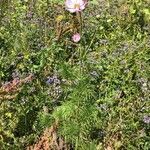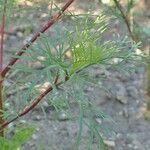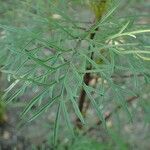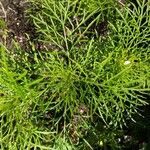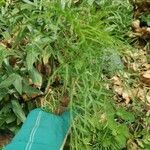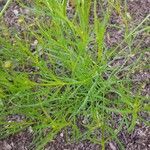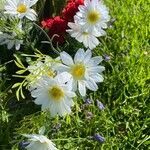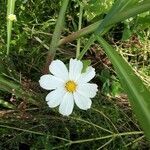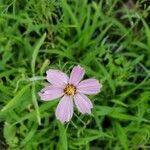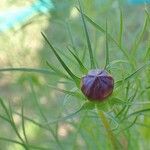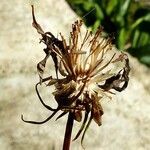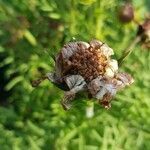Annual, usually single-stemmed from taproot, 0.5–1.0 (–2.0) m high, glabrous or minutely scabrid. Leaves ovate in outline, bipinnatifid, commonly 5–12 (–17) cm long, sessile or shortly petiolate; ultimate lobes thread-like, to 1.5 mm wide towards tip. Capitula radiate, terminal, solitary, cup-shaped, on long peduncles; outer involucral bracts deltoid-attenuate, 6–7 mm long, glabrous, green with darker lines; inner bracts lanceolate to broadly lanceolate or ovate, 7 mm long, pale green to brown with dark-lined centre and pale margins; paleae acuminate. Ray florets 4–9; ligules 20–40 (–50) mm long, pink, purple, purplish, rose-pink, violet or white. Disc florets 5–7 mm long, yellow. Achenes curved, 4-angled, linear-fusiform, 7–8 mm long, with attenuated beak (shorter in outer florets), with a few short hairs towards apex. Pappus awns (0–) 2 or 3 (–8), short, barbed.
Plants 30-200 cm tall, glabrous or sparsely puberulent, sometimes scabridulous. Leaves sessile or with petioles up to 1 cm; blade 6-11 cm, ultimate lobes to 1.5 mm wide, margin entire, apex acute. Capitula solitary, 3-6 cm in diam.; peduncles 10-20 cm; calycular bracts spreading, linear to lanceolate, 6-13 mm, apices acuminate; involucre 7-15 mm in diam.; phyllaries erect, lanceolate to ovate-lanceolate, 7-13 mm, apices rounded or obtuse. Ray corollas white, pink, or purplish, lamina obovate to oblanceolate, 15-50 mm, apices ± truncate, dentate. Disk corollas 5-7 mm. Achenes 7-16 mm, glabrous, papillose; pappus absent, or of 2 or 3 ascending to erect awns 1-3 mm. Fl. Jun-Aug. 2n = 24.
Plants 30–200 cm, glabrous or sparsely puberulent, sometimes scabridulous. Leaves: petioles 0 or to 1 cm; blades 6–11 cm, ultimate lobes to 1.5 mm wide, margins entire, apices acute (indurate). Peduncles 10–20 cm. Calyculi of spreading, linear to lanceolate bractlets 6–13 mm, apices acuminate. Involucres 7–15 mm diam. Phyllaries erect, lanceolate to ovate-lanceolate, 7–13 mm, apices round or obtuse. Ray corollas white, pink, or purplish, laminae obovate to oblanceolate, 15–50 mm, apices ± truncate, dentate. Disc corollas 5–7 mm. Cypselae 7–16 mm, glabrous, papillose; pappi 0, or of 2–3 ascending to erect awns 1–3 mm. 2n = 24.
Annual herb, up to 2.5 m high. Leaves opposite, sessile or shortly petiolate; blade ovate in outline, finely dissected, segments linear, margins entire, glabrous or thinly hispid. Heads radiate, up to 100 mm in diameter, solitary on long nude peduncles. Involucral bracts biseriate, outer row ovate with long subulate appendage, green; inner row narrowly elliptic, brownish. Receptacle paleate. Flowers: ray florets neuter, white, pink or crimson; disc florets bisexual, yellow; Dec.-Apr. Fruit with cypsela very narrowly obovate, angled, black, smooth or hispid. Pappus of 1-3 awns or absent.
Annual 6–20 dm, glabrous or minutely scabrous; lvs sessile or short-petiolate, 6–11 cm, pinnately dissected, the ultimate segments linear or linear-filiform, ca 1 mm wide or less; heads rather numerous, the disk 1–1.5 cm wide; rays ca 8, rose or lilac (white), 1.5–4 cm, often half as wide; achenes 7–16 mm, the body longer than the beak; pappus of 2 or 3 short awns, or none; 2n=24. Native of Mex. and adj. U.S., commonly cult. and casually escaped. Aug.–Oct.
Annual herb, erect, 0.6-1.3 m high. Leaves pinnatisect, 6-11 cm long, 3-5 cm wide, the segments linear, 0.4-1.2 mm wide. Capitula solitary or in few-headed cymes; peduncle 1.5-20 cm long. Ray florets 8, pink, white or red; ray 25-40 mm long; disc florets many, yellow, 6-7 mm long. Achenes 7-16 mm long, the beak 1-6 mm long; pappus of two aristae, 1-1.5 mm long.
Annual herb, up to 2.5 m high. Leaves finely dissected. Pappus awns 1-3 or absent. Flowers with white, pink or crimson rays, disc yellow.
A herb. It grows 20-200 cm tall. The leaves are 6-11 cm long and divided with sections 3-5 cm wide have final lobes 1.5 mm wide.
